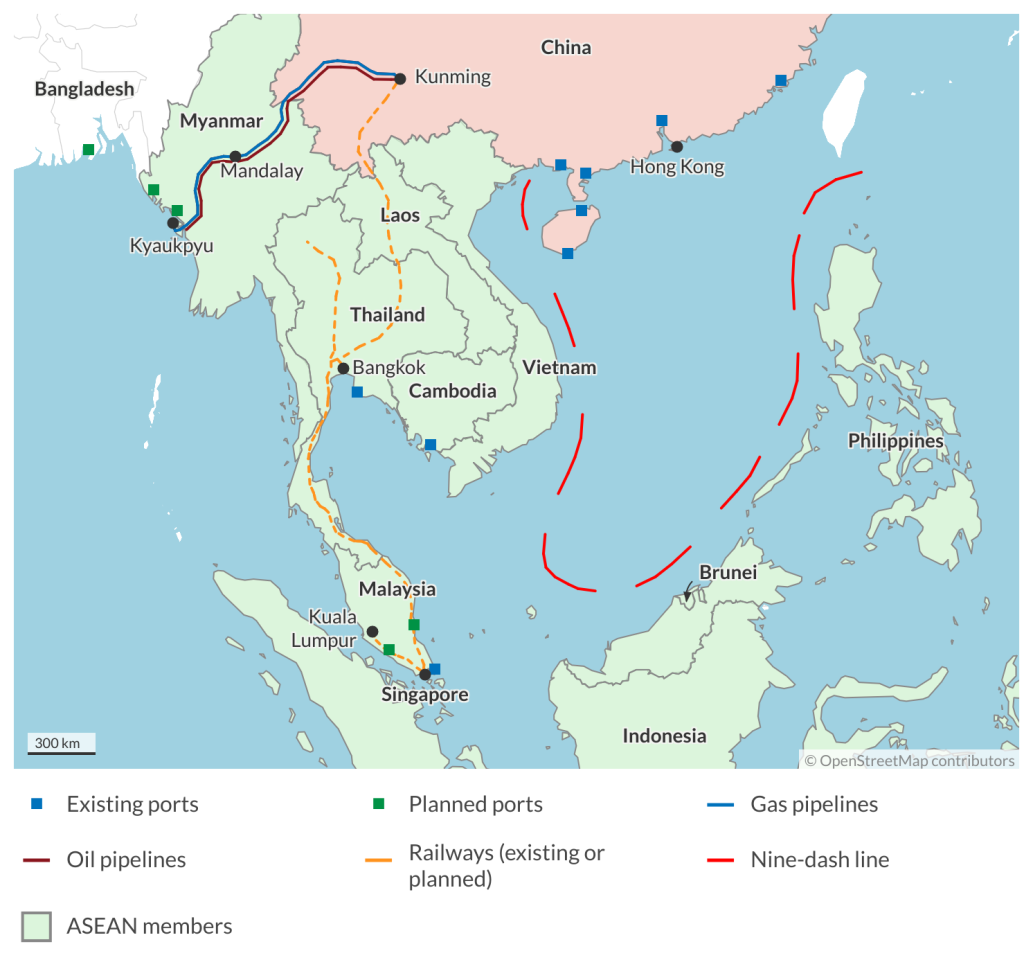Will China win over the South China Sea? – GIS Reports
Written by on January 30, 2023
China is hoping its appeal as an economic partner will boost its geopolitical influence in the South China Sea region.
In a nutshell
- Vietnam and the Philippines badly need foreign investment
- U.S. military support in the South China Sea achieved little
- China’s economic leverage could boost its regional influence
The South China Sea is a treasure trove for the seven states with territorial claims in the area – Brunei, China, Indonesia, Malaysia, the Philippines, Taiwan and Vietnam. Beijing sees it as a crucial military juncture, especially if war breaks out in the Taiwan Strait. But tensions are running high. Both China and the United States are trying to build alliances with claimant states. As a manufacturing power, China has the upper hand and can help these countries modernize their economies. It can be predicted that Washington’s single-minded focus on maritime security will not suffice to build strong ties in the region.
After the 20th National Congress, Chinese President Xi Jinping, struggling with the backlash from his zero-Covid strategy, decided to cast a wide net in foreign affairs. He turned to Southeast Asian countries, especially Vietnam, Indonesia and the Philippines. For Beijing, good relations with these countries would kill two birds with one stone. On the one hand, China would gain new markets through the Belt and Road Initiative (BRI). On the other, it would lay the foundation for solving the South China Sea issue. But Vietnam and the Philippines are tough nuts to crack for Beijing because of their ties with the U.S.
Turning Vietnam and the Philippines into allies
At the end of October last year, Beijing invited Nguyen Phu Trong, general secretary of the Communist Party of Vietnam Central Committee, as the first foreign dignitary to visit China shortly after the closing of the 20th National Congress. The two sides issued a Joint Statement on Further Strengthening and Deepening China-Vietnam Comprehensive Strategic Partnership. The document includes a plan to accelerate cooperation between China’s BRI and Vietnam’s Two Corridors and One Circle framework.
Beijing is not interested in guaranteeing the Philippines’ maritime security.
Later, Indonesian President Jokowi greeted President Xi at a bilateral meeting following the G20 Indonesia summit in Bali, calling him “elder brother.” On November 18, 2022, Mr. Xi attended an informal dialogue between APEC leaders and met several key politicians during the APEC summit in Bangkok.
President Ferdinand Marcos Jr. of the Philippines visited Beijing in early January. Before the trip, he had clearly signaled his willingness to cooperate with China. During his meeting with President Xi, he deftly evoked his personal memories of China, including his meeting with Mao Zedong during a visit to China with his mother in 1974. President Xi, who aspires to be the second Mao, appeared particularly warm toward Mr. Marcos.
Importance of the South China Sea
In recent years, China has developed disputed coral reefs in the Spratly Islands into artificial islands with airstrips and other structures, making them a potential military base. As a result, the Philippines lodged as many as 189 protests against China over this last year, 61 of them within months of Mr. Marcos taking office.
During his visit to China, the Philippine president had two suggestions: one was to create a hotline between the foreign ministries of the two countries to avoid accidental escalation. His second was to sign an agreement with China to let Beijing guarantee maritime security for Manila. While Chinese leadership appeared to have nothing against the creation of a hotline, Beijing is certainly not interested in guaranteeing the Philippines’ maritime security.
The South China Sea is of the utmost importance to China. No communist leader would dare abandon the now legendary nine-dash line. But more importantly, the South China Sea is rich in resources. In addition to fisheries, the U.S. Energy Information Administration estimates that the South China Sea has proven and probable oil and gas reserves of about 190 trillion cubic feet of natural gas and 11 billion barrels of oil.
Facts & figures
It is also rich in combustible ice (methane hydrate), which is estimated at 80 billion tons. If extracted, it would amount to 200 years of China’s oil needs. Chinese combustible ice drilling and logging technology has entered a new era of homegrown autonomy and mass production is expected to begin between 2028-2030. Beijing’s plan is to master the technology ahead of other possible competitors so that it can collaborate with South China Sea countries on cooperative exploration.
The South China Sea is also essential to China from a military standpoint. If Beijing controls its gateway, it could at least partially cut off U.S. assistance to Taiwan in case of a war in the Taiwan Strait.
For these reasons, Beijing will continue to increase its military presence – in the air as well as on and under the water. Chinese leadership will make every effort to drive the U.S. out of the South China Sea, although it knows that this will not be easy.
Divide and conquer
Recently, President Xi has evidently been hoping that disagreements between Southeast Asian nations would prevent them from forming a common front. Beijing does not want to stick to multilateralism in dealing with the South China Sea problems, preferring bilateralism instead.
Officially, China is in favor of concluding the negotiations on the Code of Conduct in the South China Sea as soon as possible. But in practice, this sort of multilateral platform is deeply unappealing to Beijing, since it allows all claimants in the region to join forces against China. President Xi would much prefer to use economic leverage to bring Southeast Asian countries back into the fold one by one. Cambodia and Laos have already become Chinese pawns. And the next targets will be Vietnam, the Philippines, and Indonesia.
China’s position on the South China Sea remains unchanged for now, but it will likely become even tougher. It categorically rejected the 2016 ruling of an arbitral tribunal established in The Hague under the United Nations Convention on the Law of the Sea. But Beijing will also likely show more flexibility in pursuing its goals.
As China intensifies its attempts to charm South China Sea countries, U.S. efforts in the region appear thin.
Beijing’s main bargaining chip here is bilateral trade and the BRI projects. South China Sea states are hungry for capital, technology, energy and infrastructure. In theory, China, as a major manufacturing nation, can meet a significant portion of that demand. Beijing believes that ASEAN as a bloc has little capacity for coordination and is unlikely to help its members achieve their economic goals.
In other words, modernization within Southeast Asia cannot be achieved without external help. In Vietnam, for example, despite the country’s considerable growth in GDP last year (8 percent), still depends on China. In the first nine months of this year, bilateral trade between Vietnam and China increased by 10 percent compared to the same period last year, accounting for 70 percent of Vietnam’s total imports. China is an essential link in Vietnam’s supply chain for raw materials and spare parts. As for the Philippines, it needs energy and infrastructure even more than Vietnam. Manila airport, for example, recently had to cancel hundreds of flights due to power outages.
Insufficient American engagement
As China intensifies its attempts to charm South China Sea countries, U.S. efforts in the region appear thin. Washington has offered claimant states military support to protect their territorial waters as well as their exclusive economic zones. But the U.S. has clearly fallen short when it comes to economic development.
Despite the launch of President Joe Biden’s Indo-Pacific Economic Framework, progress on the ground has been minimal. And overall, the U.S. and other Western countries have been unable to come up with projects to rival China’s BRI. Sending planes and warships to the South China Sea to preserve freedom of navigation is seen as a valuable asset, but this alone has not helped the region modernize its economy.
Marcos’s gains and uncertainties
Although President Marcos could not get any promise from President Xi on the South China Sea while in Beijing, the visit resulted in the signing of more than 10 agreements under the BRI framework, with cooperative investment projects in agriculture and fisheries, infrastructure, finance, customs, e-commerce, renewable energy, nickel processing, and tourism. Meanwhile, China and the Philippines have decided to restart negotiations on oil and gas development. And President Xi will likely instruct the military to temporarily slow down the building of artificial islands as a gesture of goodwill.
But whether all these projects will materialize depends on how the Chinese economy recovers. The global outlook in 2023 bodes ill for economies that depend heavily on exports.
And even if China’s economy recovers swiftly, this does not mean that all projects will be completed. President Marcos’s predecessor, former President Rodrigo Duterte, also boasted of bringing in $24 billion in investment commitments when he made his first state visit to China in 2016. But a few years later, China had delivered only a fraction of the promised investments and loans.
Scenarios
Beijing wins over the entire region
In the first scenario, the U.S. government goes overboard in its pursuit of freedom of navigation in the South China Sea and maritime security for the countries involved, while neglecting economic ties. Washington makes little effort to help the region accelerate its modernization process. Over time, Beijing’s economic and cultural influence starts to greatly exceed that of the U.S. and its allies.
Vietnam and the Philippines, which originally kept their distance from China, downplay security issues and decide to side with Beijing because it gives them greater rewards in the short and medium term. This scenario will be especially likely in the two or three years ahead if China’s economic rebound works well this year, and the U.S. and other Western countries remain unable to get out of their economic slump because of the war in Ukraine.
The West wins over key countries
In a second scenario, the U.S. and its Western allies realize that it is not enough to implement international maritime law and maritime security. Therefore, they swiftly help countries like India to achieve manufacturing capabilities equivalent at least partially to those of China so that they can compete with BRI projects through Western funding, advanced technology and India’s cheap products, raw material, and manpower.
With the support of the West, South China Sea countries gain security guarantees and economic support. Despite China’s undiminished dominance in certain areas, the states of the region align with the West.
There is a rapidly closing window of opportunity for Washington to accomplish this turnaround, but the lack of a coherent strategy for the South China Sea region makes it unlikely that this will happen in the next few years.
No significant progress
The third scenario is that the West does not help South China Sea countries develop economically, but China’s own economic decline due to Xi Jinping’s poor management maintains the status quo. Neither the U.S. nor China becomes the dominant regional player.
watch avatar the way of water full movie
watch avatar the way of water full movie
watch avatar the way of water full movie






